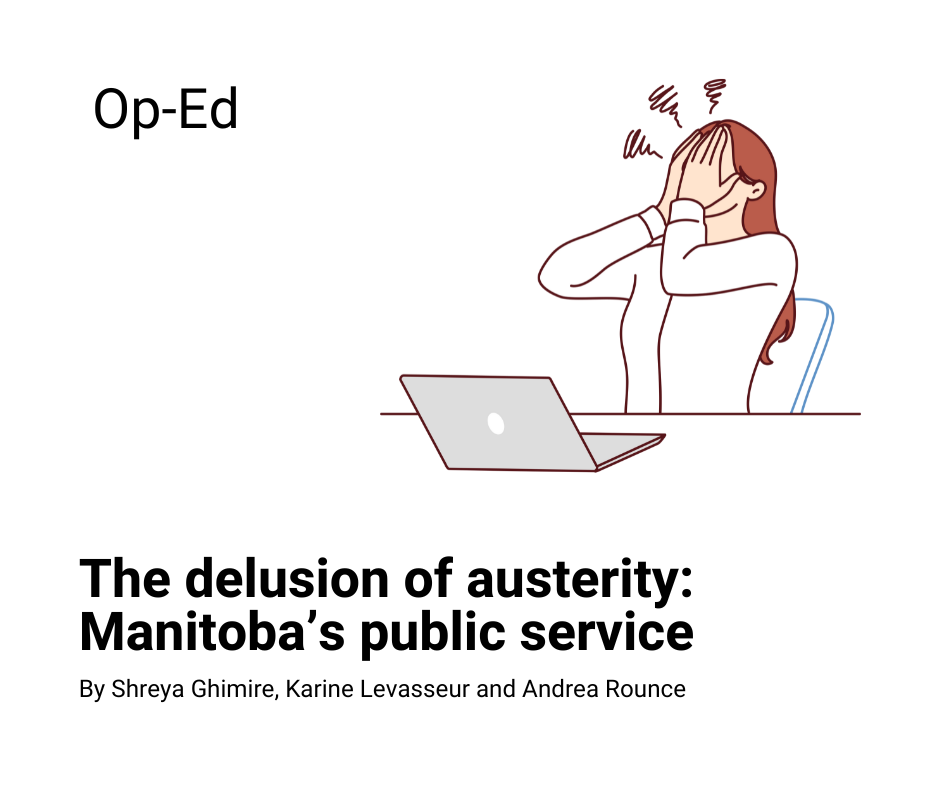Previously published in the Brandon Sun Thursday September 21, 2023

The public service in Manitoba matters to our collective well-being. While frontline public servants are easily identifiable, think of firefighters as just one example, an overlooked group of public servants are those ‘behind the scenes’ who are suffering the effects of years of government cuts and privatization, according to new research.
Who are ‘behind the scenes’ public servants? They review financial data, examine policy options prepared by front-line departments, or mitigate risk. They work in Finance, Government Services, the Public Service Commission, often doing behind-the-scenes, intellectual work that requires the trust of elected government officials. In sum, these public servants make systems work and solve problems.
Public servants working ‘behind the scenes’ have not been spared the harmful effects of austerity measures designed by the Manitoba government, according to our research, which will be published in a new book entitled: Public Service in Tough Times: Working Under Austerity in Manitoba (edited by Jesse Hajer, Ian Hudson, and Jennifer Keith). As part of this research, public servants were asked about their experiences and opinions about how the public service has dealt with austerity measures, such as spending and staffing constraints/reductions, privatization, and the contracting out of government activities over the past seven years.
Manitoba public servants are facing worsening morale, working conditions, and job satisfaction. When asked if their employment was impacted by austerity, 68% indicated that their workload has intensified or increased during the past seven years. When asked about their work schedules, most reported staffing shortages (64%), an increased number of tasks requested (58%), and hiring contract/casual staff instead of permanent staff (33%) – all of which have a significant impact on the ability of the public service to support decision-making and to deliver programs and services.
Not surprisingly, these public servants highlighted issues around recruitment and retention. Many said they were considering other employment outside of government and that contractors were being hired rather than permanent public servants. Respondents also noted that many more students and term employees were being hired – often with such low salaries that new recruits wouldn’t find them attractive. Due to wage freezes, the government is struggling to hire new recruits to work in these areas because wages are not competitive.
This dangerous mix of staff reductions, increased workloads and difficulty hiring has contributed to poor mental health within the public service. Nearly nine in ten (89%) reported that austerity measures lead to worse employee mental health.
These impacts are not surprising, but what is surprising is the insight these ‘behind the scenes’ public servants have about whether austerity strategies will not lead to cost savings and value for money in the long run.
Their answer is ‘no’.
When asked if austerity measures implemented in their area of work saved the public sector money within 1-2 years of their implementation, only 12% agreed.
Austerity measures are an uncertain strategy for cost savings in the short term and, to a majority of respondents, an infeasible one in the long term. Economists Paul Krugman and Mark Blyth refer to the disconnect between the promise of austerity for greater cost savings and its lacklustre outcomes as an example of the “austerity delusion” at work. Elimination of regulations and public oversight, often couched as “red tape reduction,” results in greater amounts of time and work for public servants (and thus costs in terms of labour output) for uneven benefit.
As one public servant predicted, the government will need to re-invest in services it has cut, though it may choose to privatize or contract out these services, which will likely cost the public more in the long run.
Adding to this is the cost of risk that the public sector becomes vulnerable to as a result of austerity measures. Respondents referred to the risks of data security breaches because of spending reductions and the increased risk of legal/civil action because of crumbling or failing public infrastructure and assets, especially when lax government oversight over these assets results in severe or deadly consequences.
Public servants who work ‘behind the scene’ are in the best position to help us understand that the benefits of austerity may, in fact, be a mirage: something that appears real is actually entirely delusional.
Shreya Ghimire is a PhD student in Political Science at York University. Karine Levasseur is a Professor and Andrea Rounce is an Associate Professor in Political Studies at the University of Manitoba. This research is affiliated with the Manitoba Research Alliance and the Canadian Centre for Policy Alternatives – Manitoba.


